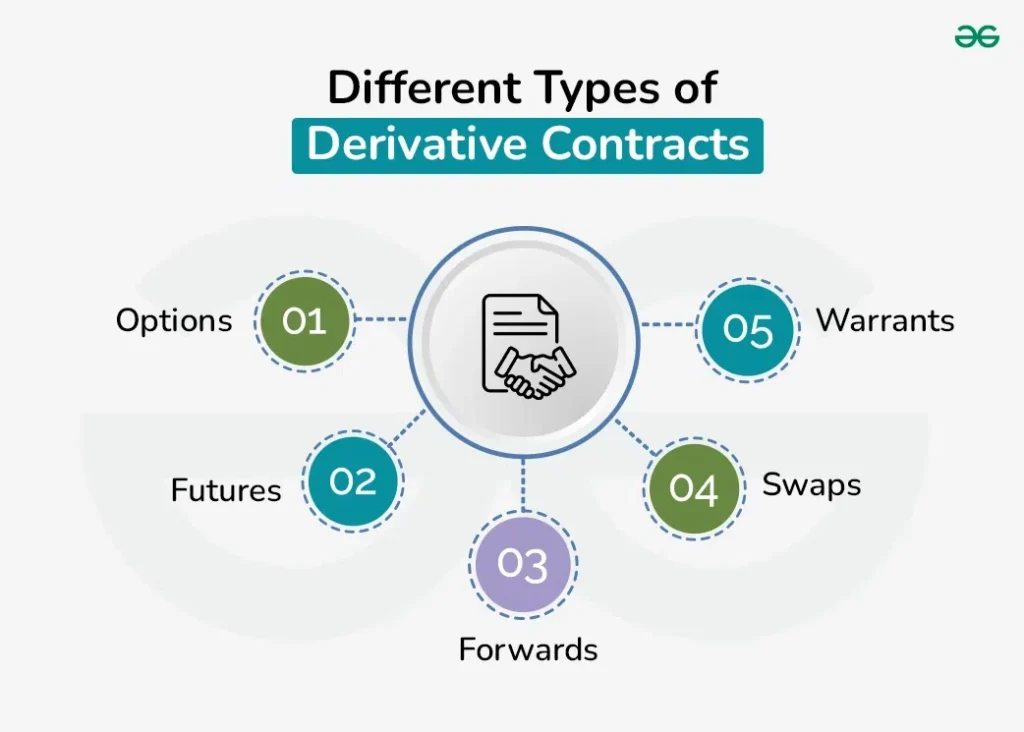In the financial world, derivatives are often discussed but rarely fully understood. If you’ve ever wondered about market derivatives or derivatives trading, you’re not alone. These financial instruments play a crucial role in the derivatives market, providing opportunities and risks for investors. This blog will break down what is derivative and explore the different types, purposes, and examples to give you a clearer picture of this complex topic.
Understanding Derivatives
Derivatives are financial arrangements whose value is derived from the performance of an underlying asset, index, or rate. In simpler terms, their worth depends on the value of something else. The derivatives market is vast and diverse, encompassing various instruments designed for different purposes.
To grasp what is a derivative, consider it as a contract between two parties. The value of this contract fluctuates with changes in the underlying asset, such as stocks, currencies, or commodities. This makes derivative trading a way to gain exposure to these assets without owning them directly.
For derivative trading, Demat account opening is essential through a registered stockbroker.
Types of Derivatives
Derivatives come in various forms, each serving different purposes and trading structures. The main types are Futures and Options trading
- Futures:
- Definition: A contract obligating the buyer to purchase, or the seller to sell, an asset at a predetermined future date and price.
- Example: A farmer selling wheat in the futures market to lock in the price months ahead.
- Market: Highly standardised and traded on exchanges.
- Forwards:
- Definition: Similar to futures, but customised contracts between two parties to buy or sell an asset at a future date for a specific price.
- Example: A company agreeing to purchase a foreign currency at a future date to hedge against currency fluctuations.
- Market: Over-the-counter (OTC), meaning they are not traded on exchanges.
- Options:
- Definition: A contract that gives the buyer the right, but not the obligation, to buy or sell an asset at a predetermined price before a certain date.
- Example: A trader buying a call option to purchase shares if the price increases.
- Market: Traded on exchanges and used for hedging or speculation.
- Swaps:
- Definition: A derivative in which two parties interchange the cash flows or liabilities from two different financial instruments.
- Example: An interest rate swap where one party agrees to pay a fixed rate while the other pays a variable rate.
- Market: OTC contracts between institutions.
Advantages and Disadvantages of Derivatives
Advantages:
- Risk Management: Derivatives are often used to hedge risks associated with price movements in the underlying asset. For instance, currency derivatives help mitigate the risks of currency fluctuations.
- Leverage: Derivatives provide significant leverage, allowing investors to control large positions with a smaller amount of capital.
- Market Efficiency: Derivatives markets contribute to the overall efficiency of the financial markets by helping in price discovery and improving liquidity.
- Speculation: Traders can use derivatives to speculate on the price movements of various assets, allowing them to make profits in both rising and falling markets.
Disadvantages:
- High Risk: Due to leverage, even a small price movement in the underlying asset can result in significant gains or losses. Derivative trading can be risky for inexperienced traders.
- Complexity: Understanding derivatives and their pricing mechanisms can be complex, making it difficult for average investors to use them effectively.
- Over-the-Counter Risks: Some derivatives, such as forwards and swaps, are traded over-the-counter, meaning they are less regulated and may involve counterparty risks.
- Speculation Risks: While speculation can be profitable, it can also result in severe losses, especially if a trader is using leverage in an incorrect or speculative manner.
Futures vs. Options: Key Differences
| Feature | Futures | Options |
| Obligation | The buyer/seller is obligated to execute the trade | Buyer has the right, but not the obligation |
| Risk | Higher risk due to obligation | Limited risk (for the buyer) |
| Potential Gain/Loss | Unlimited potential for gain or loss | Loss limited to the premium paid (for the buyer) |
| Upfront Cost | No premium is required, margin needed | Buyer pays a premium upfront |
| Expiration | Must execute on the expiration date | Can choose to execute or let it expire |
Purpose of Derivatives
Derivatives serve various purposes:
- Hedging: They are primarily used to manage risk. For example, a company that exports goods might use currency derivatives to protect against adverse fluctuations in exchange rates.
- Speculation: Traders use derivatives to bet on the future direction of prices. This can result in significant profits but also carries high risk.
- Arbitrage: Derivatives can be used to exploit price differences between markets or related assets, potentially generating profit without risk.
- Leverage: They allow investors to control a large position with a relatively small amount of capital, amplifying both potential gains and losses.
Is Derivative a Contract?
Yes, a derivative is essentially a contract between two parties. The value of the contract is derived from the performance of an underlying asset. For example, a futures contract is an agreement to buy or sell an asset at a specified future date and price. This contract outlines the terms and conditions agreed upon by both parties.
Derivatives and Speculation
While derivatives can be used for risk management, they are often viewed as speculative tools. Traders use them to bet on price movements in various markets, including equity derivatives and currency derivatives. The speculative nature of derivatives can lead to significant profits but also substantial losses, making them suitable for experienced traders.
How to Trade Derivatives
To engage in derivatives trading, you can use a Derivatives app or trading platform. These tools provide access to various derivatives markets and allow you to execute trades, manage your portfolio, and monitor market movements.
- Choose a Trading Platform: Select a platform that offers access to the derivatives market and suits your trading needs.
- Understand the Product: Educate yourself on the specific derivative instruments you plan to trade.
- Start Small: Begin with smaller positions to gain experience and understand the risks involved.
- Monitor Your Trades: Keep an eye on market conditions and your trades to make informed decisions.
Conclusion
Derivatives are powerful financial instruments used for a variety of purposes, including risk management, speculation, and market access. Whether you are interested in equity derivatives, currency derivatives, or commodity derivatives, understanding how these instruments work is crucial for any investor.
While the derivatives market offers opportunities, it’s essential to be aware of the risks involved, especially with leverage and volatility. By using a reliable Demat app or platform, traders can manage their investments effectively and navigate the complexities of derivatives trading with greater confidence. Always approach derivatives with thorough research and risk management strategies to ensure success.





